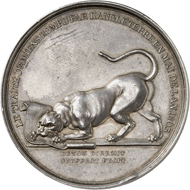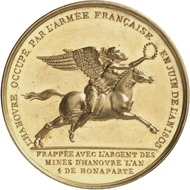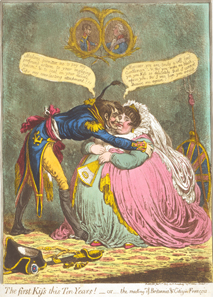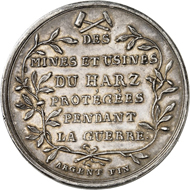One of the Napoleonic medals shows the goddess of victory Victoria in an unusual pose. She is riding on a galloping horse, holding up the laurel wreath in her right hand. Her left hand is wrapped around the horse’s neck. She is practically choking it, so that the animal does not have any other choice but to submit itself to her dictate.
France. Medal 1803 by R. V. Jeuffroy on the breaking of the Treaty of Amiens and the occupation of Hanover. From London Coin Galleries auction in association with Künker on 1 November 2016, from multiple lot 1278. Estimate: GBP 250.
Naturally, the depiction of the horse is not due to the artist’s fantasy. Instead it bears a clear political reference. “Hanover occupied by the French army in June 1803” can be read in translation on the reverse. It is thus obvious: The horse subjected by Victoria is the Saxon Steed and its portrayal on the medal is a targeted humiliation.
France. Medal 1803 the same as before in gold from the same dies. This piece from the estate of the Bonaparte family is estimated at 5 GBP,000. From London Coin Galleries auction in association with Künker on 1 November 2016, No. 1277.
This humiliation is even increased on the medal. The exergue reads (in translation): “Minted with silver from the mines of Hanover in year 4 of the regimen Bonaparte”.
The obverse is devoted to the reason for this humiliation: The leopard, heraldic animal of England, is ripping a parchment-scroll apart with its claws. It reads: “The Treaty of Amiens broken on the part of England in May of the year 1803”. And with that, Napoleon has told the beholder virtually everything, except for the truth.
In order to understand the actual reason for the conquest of Hanover, we have to travel a few years back in history. Not for many years though, since the “perpetual” peace of Amiens only lasted barely 14 months and was only signed on 25 May 1802. It ended the revolutionary wars, in which the monarchically minded Europe had little to oppose against the troops of revolutionary France. And indeed, the Treaty was a disgrace to the British. It forced them to immediately return a series of overseas possessions, they had annexed. The Cape Colony, the West Indian Islands, Egypt, Trinidad and Ceylon. France however only retreated from Naples, the Papal States and Malta.
British caricature by James Gillray: The first Kiss this Ten Years! – or – the meeting of Britannia & Citizen François. – The words of Britannia are distinctive: “Monsieur, you are truly a well-bred Gentleman! – &, tho’ you make me blush, yet, you Kiss so delicately, that I cannot refuse you, tho’ I was sure you would Deceive me again!!!”
It was a foul peace from the very beginning, even though English tourists enthusiastically flocked to France to see the revolutionists themselves. Napoleon considered the peace a sort of licence to reshape the European states according to his ideas. He interfered with German conditions and reimbursed his allied states’ loss of their territories west of the Rhine with ecclesiastical territories and mediatised imperial cities, which resulted in The Final Recess of the Imperial Deputation on 25 February 1803. He annexed the Subalpine Republic. And he replaced the Helvetic Republic with a tightly organised conglomerate of states, governed by a French protegé. In addition, he threatened the British on their very own territory, the sea. He sent one fleet respectively to Haiti and Louisiana.
Napoleon expanded his power systematically and the British did not see what they should win by continuing the peace. The war would come. And Napoleon became stronger every month. Hence the British government declared war to France on 18 May 1803. This put an end to the Peace of Amiens.
The world being carved up into spheres of influence between Pitt and Napoleon – Unfortunately Hanover was located in Europe and thus within the French emperor’s sphere of influence. Caricature by James Gillray from 1805.
The British immediately secured all French and Dutch ships, they could get hold of. Napoleon reacted by imprisoning all British tourists travelling in France and Italy. And he proceeded against the British in the place where he could harm them the most – on German soil, where George III reigned over the Electorate of Hanover in personal union. The field marshal who was in charge of the Hanover territory was completely overwhelmed. He surrendered without a fight and Napoleon had the army disarmed and dispersed.
Medal 1804. This medal, minted from the yield of the mines in the Harz region, bears the inscription (in translation): To Napoleon, the emperor of the French, the miners of the Harz production sites, whom he protected during the war. From the London Coin Galleries auction in association with Künker on 1 November 2016, No. 1279. Estimate: GBP 200.
The whole country became French administration. It could not have come worse for Hanover. The French medals were thought to demonstrate the utter humiliation of the English king.
Napoleon’s “cultural politician” Dominique-Vivant Denon was responsible for the concept. He immortalised himself on the exergue of the obverse. Denon, who was responsible for the archaeological survey of Egypt and would organize the plundering of the cultural property of the countries subjected to France, was also the director of the mint issuing the medals of Napoleon’s “Histoire Métallique”. He was experienced in classical iconography and thus created monuments of French arrogance, that still illustrate, why the Wars of Liberation against Napoleon turned into a question of faith and lead to the formation of a German national identity.
The medals whose story we have told here come from the Preussag collection and will be auctioned on 1 November 2016 at London Coin Galleries in London in association with Künker.
The auction where these medals are being offered, can be viewed online.
And you can read a complete auction preview of this auction in CoinsWeekly.











